
This stitched aerial drone photo taken on Jan. 23, 2024 shows the Wan'an Bridge, a wooden arch bridge, in Changqiao Township of Pingnan County, southeast China's Fujian Province.
Three Chinese cultural elements, namely traditional Li textile techniques: spinning, dyeing, weaving and embroidering, Qiang New Year festival, celebrated in China's Sichuan province, and traditional design and practices for building Chinese wooden arch bridges, were added by UNESCO to its Representative List of Intangible Cultural Heritage of Humanity during the 19th session of the Intergovernmental Committee for the Safeguarding of Intangible Cultural Heritage held in Asuncion, Paraguay, on Thursday. (Photo by Wang Zhiling/Xinhua)

A drone photo taken on Aug. 18, 2022 shows the Rulong Bridge, a wooden arch bridge, in Qingyuan County of Lishui City, east China's Zhejiang Province.
Three Chinese cultural elements, namely traditional Li textile techniques: spinning, dyeing, weaving and embroidering, Qiang New Year festival, celebrated in China's Sichuan province, and traditional design and practices for building Chinese wooden arch bridges, were added by UNESCO to its Representative List of Intangible Cultural Heritage of Humanity during the 19th session of the Intergovernmental Committee for the Safeguarding of Intangible Cultural Heritage held in Asuncion, Paraguay, on Thursday. (Photo by Wu Chunping/Xinhua)

This photo taken on Oct. 1, 2019 shows the Luanfeng Bridge, a wooden arch bridge, in Xiadang Township of Shouning County, southeast China's Fujian Province.
Three Chinese cultural elements, namely traditional Li textile techniques: spinning, dyeing, weaving and embroidering, Qiang New Year festival, celebrated in China's Sichuan province, and traditional design and practices for building Chinese wooden arch bridges, were added by UNESCO to its Representative List of Intangible Cultural Heritage of Humanity during the 19th session of the Intergovernmental Committee for the Safeguarding of Intangible Cultural Heritage held in Asuncion, Paraguay, on Thursday. (Photo by Wang Zhiling/Xinhua)
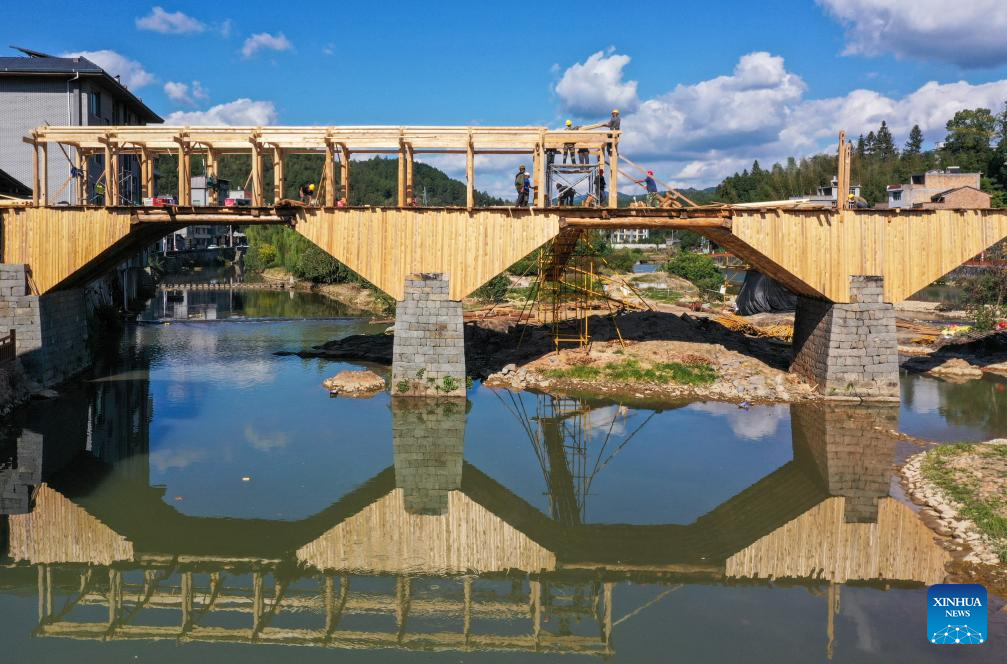
A drone photo taken on Nov. 2, 2023 shows workers working on the restoration of the Wan'an Bridge, a wooden arch bridge, in Changqiao Township of Pingnan County, southeast China's Fujian Province.
Three Chinese cultural elements, namely traditional Li textile techniques: spinning, dyeing, weaving and embroidering, Qiang New Year festival, celebrated in China's Sichuan province, and traditional design and practices for building Chinese wooden arch bridges, were added by UNESCO to its Representative List of Intangible Cultural Heritage of Humanity during the 19th session of the Intergovernmental Committee for the Safeguarding of Intangible Cultural Heritage held in Asuncion, Paraguay, on Thursday. (Photo by Wang Zhiling/Xinhua)

An aerial drone photo taken on Jan. 23, 2024 shows the Yonggui Bridge, a wooden arch bridge, after snowfall in Qingyuan County of Lishui City, east China's Zhejiang Province.
Three Chinese cultural elements, namely traditional Li textile techniques: spinning, dyeing, weaving and embroidering, Qiang New Year festival, celebrated in China's Sichuan province, and traditional design and practices for building Chinese wooden arch bridges, were added by UNESCO to its Representative List of Intangible Cultural Heritage of Humanity during the 19th session of the Intergovernmental Committee for the Safeguarding of Intangible Cultural Heritage held in Asuncion, Paraguay, on Thursday. (Photo by Wu Chunping/Xinhua)

This photo taken on Feb. 21, 2022 shows the Qiancheng Bridge, a wooden arch bridge, in Tangkou Township of Pingnan County, southeast China's Fujian Province.
Three Chinese cultural elements, namely traditional Li textile techniques: spinning, dyeing, weaving and embroidering, Qiang New Year festival, celebrated in China's Sichuan province, and traditional design and practices for building Chinese wooden arch bridges, were added by UNESCO to its Representative List of Intangible Cultural Heritage of Humanity during the 19th session of the Intergovernmental Committee for the Safeguarding of Intangible Cultural Heritage held in Asuncion, Paraguay, on Thursday. (Photo by Wang Zhiling/Xinhua)

A drone photo taken on Oct. 18, 2023 shows workers working on the restoration of the Wan'an Bridge, a wooden arch bridge, in Changqiao Township of Pingnan County, southeast China's Fujian Province.
Three Chinese cultural elements, namely traditional Li textile techniques: spinning, dyeing, weaving and embroidering, Qiang New Year festival, celebrated in China's Sichuan province, and traditional design and practices for building Chinese wooden arch bridges, were added by UNESCO to its Representative List of Intangible Cultural Heritage of Humanity during the 19th session of the Intergovernmental Committee for the Safeguarding of Intangible Cultural Heritage held in Asuncion, Paraguay, on Thursday. (Photo by Wang Zhiling/Xinhua)

Workers lift tiles to restore the rooftop of the Wan'an Bridge, a wooden arch bridge, in Changqiao Township of Pingnan County, southeast China's Fujian Province, Nov. 29, 2023.
Three Chinese cultural elements, namely traditional Li textile techniques: spinning, dyeing, weaving and embroidering, Qiang New Year festival, celebrated in China's Sichuan province, and traditional design and practices for building Chinese wooden arch bridges, were added by UNESCO to its Representative List of Intangible Cultural Heritage of Humanity during the 19th session of the Intergovernmental Committee for the Safeguarding of Intangible Cultural Heritage held in Asuncion, Paraguay, on Thursday. (Photo by Wang Zhiling/Xinhua)

Workers work on the restoration of the Wan'an Bridge, a wooden arch bridge, in Changqiao Township of Pingnan County, southeast China's Fujian Province, Nov. 2, 2023.
Three Chinese cultural elements, namely traditional Li textile techniques: spinning, dyeing, weaving and embroidering, Qiang New Year festival, celebrated in China's Sichuan province, and traditional design and practices for building Chinese wooden arch bridges, were added by UNESCO to its Representative List of Intangible Cultural Heritage of Humanity during the 19th session of the Intergovernmental Committee for the Safeguarding of Intangible Cultural Heritage held in Asuncion, Paraguay, on Thursday. (Photo by Wang Zhiling/Xinhua)

This aerial drone photo taken on Dec. 2, 2023 shows workers laying tiles on the rooftop of the Wan'an Bridge, a wooden arch bridge, in Changqiao Township of Pingnan County, southeast China's Fujian Province.
Three Chinese cultural elements, namely traditional Li textile techniques: spinning, dyeing, weaving and embroidering, Qiang New Year festival, celebrated in China's Sichuan province, and traditional design and practices for building Chinese wooden arch bridges, were added by UNESCO to its Representative List of Intangible Cultural Heritage of Humanity during the 19th session of the Intergovernmental Committee for the Safeguarding of Intangible Cultural Heritage held in Asuncion, Paraguay, on Thursday. (Photo by Wang Zhiling/Xinhua)

This stitched aerial drone photo taken on Jan. 23, 2024 shows the Wan'an Bridge, a wooden arch bridge, in Changqiao Township of Pingnan County, southeast China's Fujian Province.
Three Chinese cultural elements, namely traditional Li textile techniques: spinning, dyeing, weaving and embroidering, Qiang New Year festival, celebrated in China's Sichuan province, and traditional design and practices for building Chinese wooden arch bridges, were added by UNESCO to its Representative List of Intangible Cultural Heritage of Humanity during the 19th session of the Intergovernmental Committee for the Safeguarding of Intangible Cultural Heritage held in Asuncion, Paraguay, on Thursday. (Photo by Wang Zhiling/Xinhua)

Villagers participate in a traditional folk activity of the Duanwu Festival, or the Dragon Boat Festival, at Shuangmen Bridge, a wooden arch bridge, in Qingyuan County of Lishui City, east China's Zhejiang Province, June 11, 2024.
Three Chinese cultural elements, namely traditional Li textile techniques: spinning, dyeing, weaving and embroidering, Qiang New Year festival, celebrated in China's Sichuan province, and traditional design and practices for building Chinese wooden arch bridges, were added by UNESCO to its Representative List of Intangible Cultural Heritage of Humanity during the 19th session of the Intergovernmental Committee for the Safeguarding of Intangible Cultural Heritage held in Asuncion, Paraguay, on Thursday. (Photo by Wu Chunping/Xinhua)

A craftswoman of Li ethnic group shows a pendant with traditional Li textile elements at home in Donghe Town of Dongfang City, south China's Hainan Province, June 7, 2023.
Three Chinese cultural elements, namely traditional Li textile techniques: spinning, dyeing, weaving and embroidering, Qiang New Year festival, celebrated in China's Sichuan province, and traditional design and practices for building Chinese wooden arch bridges, were added by UNESCO to its Representative List of Intangible Cultural Heritage of Humanity during the 19th session of the Intergovernmental Committee for the Safeguarding of Intangible Cultural Heritage held in Asuncion, Paraguay, on Thursday. (Xinhua/Pu Xiaoxu)

An elderly woman of Li ethnic group demonstrates Li brocade weaving techniques at Binglanggu tourism area in Baoting Li and Miao Autonomous County, south China's Hainan Province, Nov. 4, 2024.
Three Chinese cultural elements, namely traditional Li textile techniques: spinning, dyeing, weaving and embroidering, Qiang New Year festival, celebrated in China's Sichuan province, and traditional design and practices for building Chinese wooden arch bridges, were added by UNESCO to its Representative List of Intangible Cultural Heritage of Humanity during the 19th session of the Intergovernmental Committee for the Safeguarding of Intangible Cultural Heritage held in Asuncion, Paraguay, on Thursday. (Xinhua/Pu Xiaoxu)

An elderly woman of Li ethnic group demonstrates spinning techniques of Li brocade making at Binglanggu tourism area in Baoting Li and Miao Autonomous County, south China's Hainan Province, Nov. 4, 2024.
Three Chinese cultural elements, namely traditional Li textile techniques: spinning, dyeing, weaving and embroidering, Qiang New Year festival, celebrated in China's Sichuan province, and traditional design and practices for building Chinese wooden arch bridges, were added by UNESCO to its Representative List of Intangible Cultural Heritage of Humanity during the 19th session of the Intergovernmental Committee for the Safeguarding of Intangible Cultural Heritage held in Asuncion, Paraguay, on Thursday. (Xinhua/Pu Xiaoxu)

A Li brocade work is displayed during a culture exhibition at a theme park of the Boao Forum for Asia in Boao, south China's Hainan Province, April 20, 2022.
Three Chinese cultural elements, namely traditional Li textile techniques: spinning, dyeing, weaving and embroidering, Qiang New Year festival, celebrated in China's Sichuan province, and traditional design and practices for building Chinese wooden arch bridges, were added by UNESCO to its Representative List of Intangible Cultural Heritage of Humanity during the 19th session of the Intergovernmental Committee for the Safeguarding of Intangible Cultural Heritage held in Asuncion, Paraguay, on Thursday. (Xinhua/Zhang Liyun)

Competitors make Li brocade works during a skills competition in Ledong Li Autonomous County, south China's Hainan Province, April 23, 2023.
Three Chinese cultural elements, namely traditional Li textile techniques: spinning, dyeing, weaving and embroidering, Qiang New Year festival, celebrated in China's Sichuan province, and traditional design and practices for building Chinese wooden arch bridges, were added by UNESCO to its Representative List of Intangible Cultural Heritage of Humanity during the 19th session of the Intergovernmental Committee for the Safeguarding of Intangible Cultural Heritage held in Asuncion, Paraguay, on Thursday. (Xinhua/Fan Yuqing)
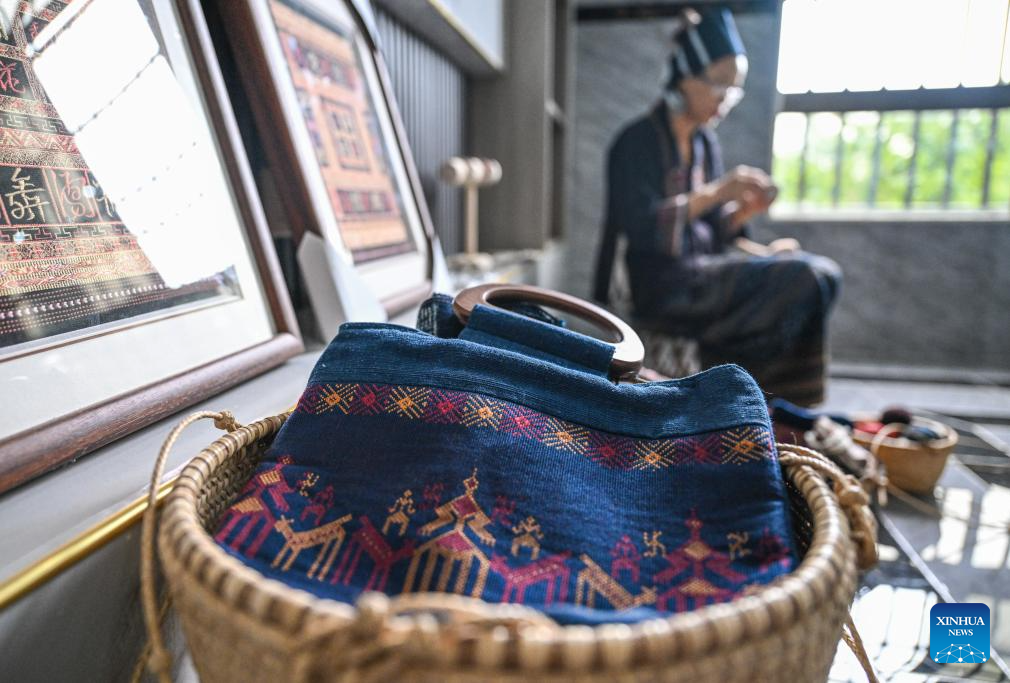
This photo taken on June 7, 2023 shows handbags made from Li textiles by Fu Yongying, a provincial-level inheritor of the traditional Li textile techniques, in Donghe Town of Dongfang City, south China's Hainan Province.
Three Chinese cultural elements, namely traditional Li textile techniques: spinning, dyeing, weaving and embroidering, Qiang New Year festival, celebrated in China's Sichuan province, and traditional design and practices for building Chinese wooden arch bridges, were added by UNESCO to its Representative List of Intangible Cultural Heritage of Humanity during the 19th session of the Intergovernmental Committee for the Safeguarding of Intangible Cultural Heritage held in Asuncion, Paraguay, on Thursday. (Xinhua/Pu Xiaoxu)
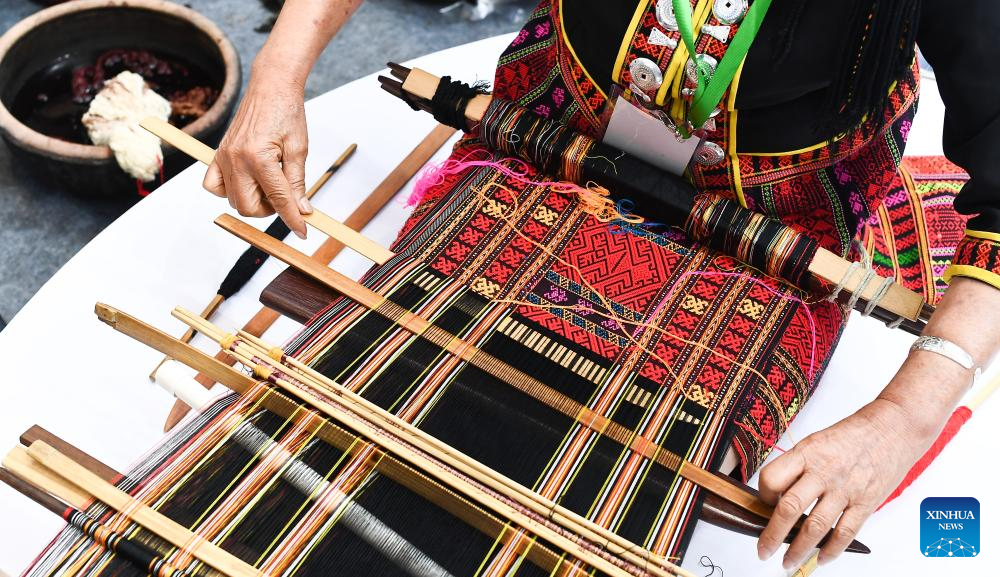
A craftswoman demonstrates Li brocade weaving techniques during an exhibition on textile techniques held in Haikou, south China's Hainan Province, April 30, 2023.
Three Chinese cultural elements, namely traditional Li textile techniques: spinning, dyeing, weaving and embroidering, Qiang New Year festival, celebrated in China's Sichuan province, and traditional design and practices for building Chinese wooden arch bridges, were added by UNESCO to its Representative List of Intangible Cultural Heritage of Humanity during the 19th session of the Intergovernmental Committee for the Safeguarding of Intangible Cultural Heritage held in Asuncion, Paraguay, on Thursday. (Xinhua/Yang Guanyu)

Fu Yongying, a provincial-level inheritor of the traditional Li textile techniques, demonstrates skills at an exhibition hall in Dongfang City, south China's Hainan Province, June 6, 2023.
Three Chinese cultural elements, namely traditional Li textile techniques: spinning, dyeing, weaving and embroidering, Qiang New Year festival, celebrated in China's Sichuan province, and traditional design and practices for building Chinese wooden arch bridges, were added by UNESCO to its Representative List of Intangible Cultural Heritage of Humanity during the 19th session of the Intergovernmental Committee for the Safeguarding of Intangible Cultural Heritage held in Asuncion, Paraguay, on Thursday. (Xinhua/Pu Xiaoxu)
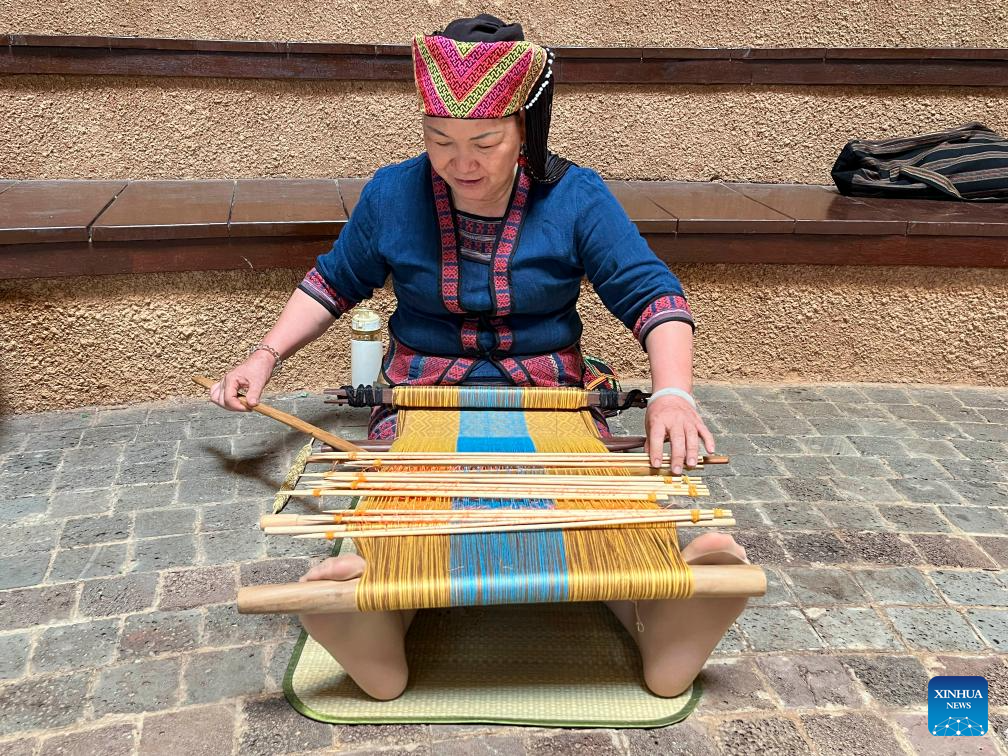
Liu Xianglan, a national-level inheritor of traditional Li textile techniques, demonstrates Li brocade weaving techniques in Maona Village, Wuzhishan City, south China's Hainan Province, May 22, 2024.
Three Chinese cultural elements, namely traditional Li textile techniques: spinning, dyeing, weaving and embroidering, Qiang New Year festival, celebrated in China's Sichuan province, and traditional design and practices for building Chinese wooden arch bridges, were added by UNESCO to its Representative List of Intangible Cultural Heritage of Humanity during the 19th session of the Intergovernmental Committee for the Safeguarding of Intangible Cultural Heritage held in Asuncion, Paraguay, on Thursday. (Xinhua/Cheng Xiao)

A craftswoman of Li ethnic group shows a pair of earrings with traditional Li textile elements at home in Donghe Town of Dongfang City, south China's Hainan Province, June 7, 2023.
Three Chinese cultural elements, namely traditional Li textile techniques: spinning, dyeing, weaving and embroidering, Qiang New Year festival, celebrated in China's Sichuan province, and traditional design and practices for building Chinese wooden arch bridges, were added by UNESCO to its Representative List of Intangible Cultural Heritage of Humanity during the 19th session of the Intergovernmental Committee for the Safeguarding of Intangible Cultural Heritage held in Asuncion, Paraguay, on Thursday. (Xinhua/Pu Xiaoxu)

Local people perform dance to celebrate Qiang New Year festival in Maoxian County, southwest China's Sichuan Province, Nov. 1, 2024.
Three Chinese cultural elements, namely traditional Li textile techniques: spinning, dyeing, weaving and embroidering, Qiang New Year festival, celebrated in China's Sichuan province, and traditional design and practices for building Chinese wooden arch bridges, were added by UNESCO to its Representative List of Intangible Cultural Heritage of Humanity during the 19th session of the Intergovernmental Committee for the Safeguarding of Intangible Cultural Heritage held in Asuncion, Paraguay, on Thursday. (Photo by He Qinghai/Xinhua)

Local people perform dance to celebrate Qiang New Year festival in Maoxian County, southwest China's Sichuan Province, Nov. 1, 2024.
Three Chinese cultural elements, namely traditional Li textile techniques: spinning, dyeing, weaving and embroidering, Qiang New Year festival, celebrated in China's Sichuan province, and traditional design and practices for building Chinese wooden arch bridges, were added by UNESCO to its Representative List of Intangible Cultural Heritage of Humanity during the 19th session of the Intergovernmental Committee for the Safeguarding of Intangible Cultural Heritage held in Asuncion, Paraguay, on Thursday. (Photo by He Qinghai/Xinhua)
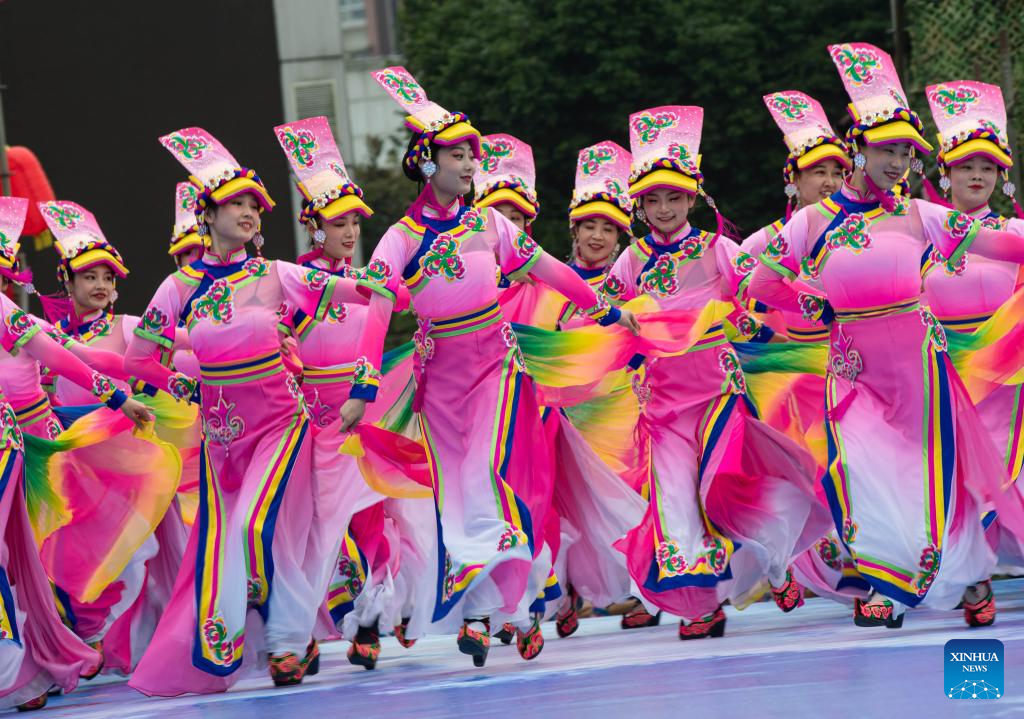
Students of Qiang ethnic group perform dance to celebrate Qiang New Year festival at a square in Beichuan Qiang Autonomous County, southwest China's Sichuan Province, Nov. 14, 2020.
Three Chinese cultural elements, namely traditional Li textile techniques: spinning, dyeing, weaving and embroidering, Qiang New Year festival, celebrated in China's Sichuan province, and traditional design and practices for building Chinese wooden arch bridges, were added by UNESCO to its Representative List of Intangible Cultural Heritage of Humanity during the 19th session of the Intergovernmental Committee for the Safeguarding of Intangible Cultural Heritage held in Asuncion, Paraguay, on Thursday. (Xinhua/Jiang Hongjing)

An aerial drone photo taken on Nov. 14, 2020 shows people watching a music fountain show during Qiang New Year festival holiday at a square in Beichuan Qiang Autonomous County, southwest China's Sichuan Province.
Three Chinese cultural elements, namely traditional Li textile techniques: spinning, dyeing, weaving and embroidering, Qiang New Year festival, celebrated in China's Sichuan province, and traditional design and practices for building Chinese wooden arch bridges, were added by UNESCO to its Representative List of Intangible Cultural Heritage of Humanity during the 19th session of the Intergovernmental Committee for the Safeguarding of Intangible Cultural Heritage held in Asuncion, Paraguay, on Thursday. (Xinhua/Jiang Hongjing)

Local people perform dragon dance to celebrate Qiang New Year festival at a square in Beichuan Qiang Autonomous County, southwest China's Sichuan Province, Nov. 14, 2020.
Three Chinese cultural elements, namely traditional Li textile techniques: spinning, dyeing, weaving and embroidering, Qiang New Year festival, celebrated in China's Sichuan province, and traditional design and practices for building Chinese wooden arch bridges, were added by UNESCO to its Representative List of Intangible Cultural Heritage of Humanity during the 19th session of the Intergovernmental Committee for the Safeguarding of Intangible Cultural Heritage held in Asuncion, Paraguay, on Thursday. (Xinhua/Jiang Hongjing)
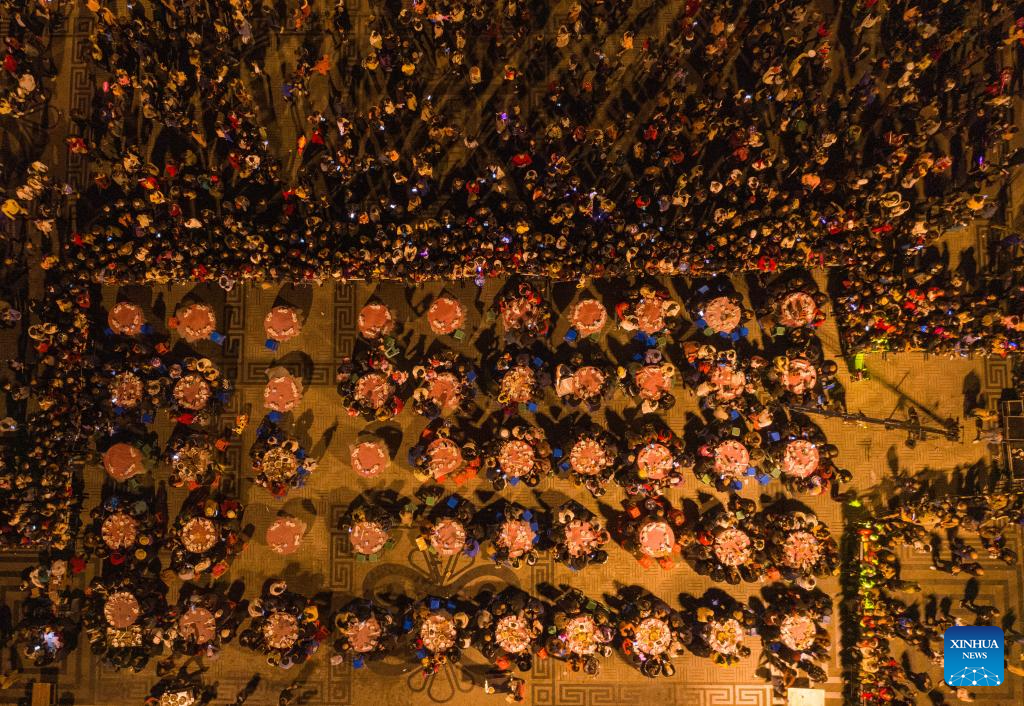
An aerial drone photo taken on Nov. 14, 2020 shows residents attending a group banquet at a square in Beichuan Qiang Autonomous County, southwest China's Sichuan Province.
Three Chinese cultural elements, namely traditional Li textile techniques: spinning, dyeing, weaving and embroidering, Qiang New Year festival, celebrated in China's Sichuan province, and traditional design and practices for building Chinese wooden arch bridges, were added by UNESCO to its Representative List of Intangible Cultural Heritage of Humanity during the 19th session of the Intergovernmental Committee for the Safeguarding of Intangible Cultural Heritage held in Asuncion, Paraguay, on Thursday. (Xinhua/Jiang Hongjing)



